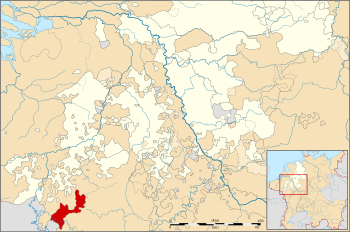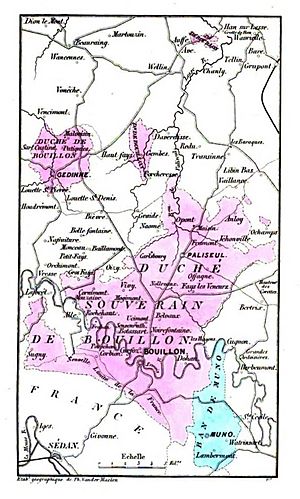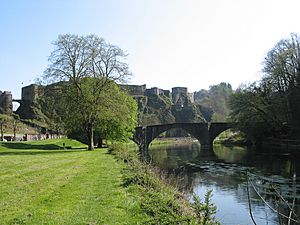Duchy of Bouillon facts for kids
Quick facts for kids
Duchy of Bouillon
Duché de Bouillon
|
|||||||||
|---|---|---|---|---|---|---|---|---|---|
| 1456? – 1794 | |||||||||

The Duchy of Bouillon as at 1560, shown within the Lower Rhenish–Westphalian Circle
|
|||||||||
| Status |
|
||||||||
| Capital | Bouillon | ||||||||
| Common languages | Walloon | ||||||||
| Government | Dukedom | ||||||||
| Historical era | Middle Ages | ||||||||
|
• Ardennes lords of Bouillon
|
by the 11th century | ||||||||
|
• La Marck châtelains
|
from 1415 the 15th century | ||||||||
|
• First style of Duke
|
1456 | ||||||||
|
• Treaties of Nijmegen
|
1678 | ||||||||
26 May 1790 |
|||||||||
| 23 March or 1 May 1792 | |||||||||
|
• Proclamation of the
Republic |
24 April 1794 |
||||||||
|
• Annexed to France
|
26 October 1795 (4 Brumaire, Year IV) |
||||||||
|
|||||||||
| Today part of | Belgium | ||||||||
The Duchy of Bouillon (French: Duché de Bouillon) was a small country in Europe. It was ruled by a duke. Today, this area is part of Belgium.
The Duchy started in the 10th century. It was first owned by the Lords of Bouillon. They lived in Bouillon Castle. In 1095, a famous crusader named Godfrey of Bouillon sold Bouillon. He sold it to the Prince-Bishopric of Liège to pay for his trip to the First Crusade.
After this, the Prince-Bishops of Liège became the lords of Bouillon. They eventually started calling themselves "Dukes." Later, two powerful families, the La Marck and La Tour d'Auvergne families, claimed the Duchy. From 1678, Bouillon became a country under the protection of France. The La Tour family ruled it. France took over Bouillon completely in 1795.
Contents
Geography of Bouillon
The Duchy of Bouillon was an independent country until 1795. In 1789, about 2,500 people lived there. The biggest town was Bouillon. It is located on the Semois river.
The Duchy also included several nearby villages. Some of these were Sugny, Corbion, Alle, Rochehaut, and Ucimont. The people in Bouillon spoke Walloon.
History of the Duchy
| History of the Low Countries | ||||||||
|---|---|---|---|---|---|---|---|---|
| Frisii | Belgae | |||||||
| Cana- nefates |
Chamavi, Tubantes |
Gallia Belgica (55 BC – 5th c. AD) Germania Inferior (83 – 5th c.) |
||||||
| Salian Franks | Batavi | |||||||
| unpopulated (4th–5th c.) |
Saxons | Salian Franks (4th–5th c.) |
||||||
| Frisian Kingdom (6th c.–734) |
Frankish Kingdom (481–843)—Carolingian Empire (800–843) | |||||||
| Austrasia (511–687) | ||||||||
| Middle Francia (843–855) | West Francia (843–) |
|||||||
| Kingdom of Lotharingia (855– 959) Duchy of Lower Lorraine (959–) |
||||||||
| Frisia | ||||||||
Frisian Freedom (11–16th century) |
County of Holland (880–1432) |
Bishopric of Utrecht (695–1456) |
Duchy of Brabant (1183–1430) Duchy of Guelders (1046–1543) |
County of Flanders (862–1384) |
County of Hainaut (1071–1432) County of Namur (981–1421) |
P.-Bish. of Liège (980–1794) |
Duchy of Luxem- bourg (1059–1443) |
|
Burgundian Netherlands (1384–1482) |
||||||||
Habsburg Netherlands (1482–1795) (Seventeen Provinces after 1543) |
||||||||
Dutch Republic (1581–1795) |
Spanish Netherlands (1556–1714) |
|||||||
Austrian Netherlands (1714–1795) |
||||||||
United States of Belgium (1790) |
R. Liège (1789–'91) |
|||||||
Batavian Republic (1795–1806) Kingdom of Holland (1806–1810) |
associated with French First Republic (1795–1804) part of First French Empire (1804–1815) |
|||||||
Princip. of the Netherlands (1813–1815) |
||||||||
| United Kingdom of the Netherlands (1815–1830) | Gr D. L. (1815–) |
|||||||
Kingdom of the Netherlands (1839–) |
Kingdom of Belgium (1830–) |
|||||||
| Gr D. of Luxem- bourg (1890–) |
||||||||
The exact start of the Duchy of Bouillon is not fully clear. The first mention of Bouillon Castle was in the year 988. By the 11th century, the castle and land were owned by the House of Ardennes. They were known as the Lords of Bouillon.
In 1069, Godfrey III, Duke of Lower Lorraine died. Bouillon then went to his nephew, Godfrey of Bouillon. In 1095, Godfrey of Bouillon sold Bouillon to Otbert, the Prince-Bishop of Liège. He needed money to join the First Crusade. Godfrey later became the first ruler of the Kingdom of Jerusalem.
Prince-Bishops and the La Marck Family
The Prince-Bishop of Liège gave control of Bouillon Castle to the House of La Marck family in 1415. In 1456, Louis de Bourbon, Bishop of Liège became the first person to call himself "Duke of Bouillon."
In 1482, William de La Marck, who was in charge of Bouillon Castle, had Louis killed. William wanted his son, Jean de la Marck, to become Prince-Bishop. But this plan failed. John of Hornes was chosen as the new Prince-Bishop. John then fought a war against William. They signed a peace treaty in 1484. The La Marck family gave up their claim to Liège. However, they kept Bouillon Castle. They held it as a promise for a loan and for their help to the Prince-Bishop.
In 1492, Robert II de la Marck also started calling himself "Duke of Bouillon." But in 1521, Érard de La Marck, who was the Prince-Bishop of Liège and Robert's brother, took Bouillon back. He had help from the army of Charles V, Holy Roman Emperor.
Later, Robert Fleuranges III de La Marck and his son Robert IV also used the title "Duke of Bouillon." During a war from 1551 to 1559, French forces took over Bouillon. This was to keep it safe from the Habsburg family. But the French king, Henry II of France, still recognized Robert IV as the Duke.
The La Tour d'Auvergne Family
From 1560 to 1642, the Dukes of Bouillon also ruled the independent Principality of Sedan.
When Charlotte de La Marck died in 1594, the Duchy and its title went to her husband, Henri de La Tour d'Auvergne. From then on, the House of La Tour d'Auvergne owned Bouillon.
France invaded Bouillon again in 1676 during the Franco-Dutch War. But Godefroy Maurice de La Tour d'Auvergne kept his title as Duke. From this time, the Duchy of Bouillon was officially part of the Holy Roman Empire. But in reality, it was protected by France. This was confirmed by the Treaties of Nijmegen in 1678.
End of the Duchy
After the French Revolution, the French army invaded the Duchy of Bouillon in 1794. They created a short-lived country called the Republic of Bouillon. In 1795, Bouillon became part of France. The last duke, Jacques Léopold de La Tour d'Auvergne, died in 1802. He had no children, and his family line ended.
In 1815, after the wars in Europe, the Congress of Vienna decided who should be the "Duke of Bouillon." They chose Charles Alain Gabriel de Rohan. He was a relative of the last duke. However, the Duchy of Bouillon itself was added to the Grand Duchy of Luxembourg. Luxembourg was then connected to the Kingdom of the Netherlands. Later, in 1830, it became part of Belgium. The arguments over who truly owned Bouillon and its title continued until 1825.
Ruling Families of Bouillon
Over the centuries, several powerful families ruled or claimed the title of Duke of Bouillon:
- Lords of Bouillon (before 1095): The first known rulers of the area.
- Prince-Bishops of Liège (1095–1415, and later claiming the title): They bought Bouillon and controlled it for a long time. Some of them later called themselves Dukes.
- House of La Marck (from 1415, claiming the title of Duke from 1492): This family controlled Bouillon Castle and often fought with the Prince-Bishops over the Duchy.
- House of La Tour d'Auvergne (1594–1802): This family officially held the title of Duke and ruled Bouillon as a French protectorate.
- House of Rohan (from 1816, claiming the title): After the Duchy was gone, this family was given the title of Duke of Bouillon.
See also
- Duchess of Bouillon
- Prince of Sedan






